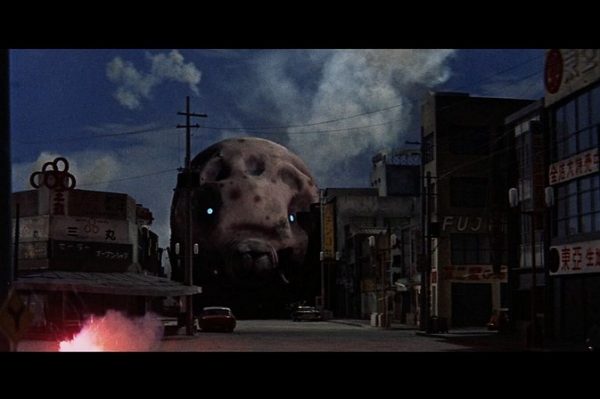Godzilla and Rodan director Ishirô Honda returned to the kaiju format that forged his reputation, with a lighter tone and a more hopeful outlook. Mothra still howls against the atomic age as in his earlier city-trashers, yet there is more than a little dose of pure magic creeping in with the radiation. In fact, the bright colours and blend of sci-fi and music give it a psychedelic, even kitsch aura that predates the proliferation of that style later in the decade. Perhaps it is harder to be serious facing a giant moth than a massive lizard or a pterodactyl, but in comparison to the grim tone of his early monster movies, Mothra is endlessly charming and entertaining even as it lists slightly towards camp.
Atomic testing proves the catalyst for the events yet again, but only so far in that the film begins with an expedition to rescue Japanese sailors stranded on Infant Island, the site or recent nuclear activity. Scientists and officials are baffled by the sailors’ good health and claims that they were saved by the natives of the island. An expedition is mounted, including scientists, a shady half-Japanese business called Clark Nelson (Jerry Itô), and a stowaway reporter called Senichiro Fukuda (Furankî Sakai). Far from an irradiated wasteland, Infant Island is a lush haven populated by vaguely Polynesian islanders and a pair of foot-high fairies (Japanese pop twins The Peanuts, Emi and Yumi Itō). Most of the crew decide to leave and keep the islanders’ secret. However, sensing vast profit, Nelson returns and kidnaps the sisters, forcing them to perform for thousands of paying concert-goers. Unknown to Nelson, they share a telepathic bond with another resident of the island, a giant egg that contains a massive caterpillar. Their song “Mosura No Uta” calls Mothra across the sea to bring the fairies home.
It is a deeply eccentric story and a real departure from the Honda’s previous seminal creature feature. At its core, Mothra bears close resemblance to the plot of King Kong, as corporate greed fails to control an elemental force removed from its natural habitat, and a city pays the dire consequence. Next to the bonkers airborne threat of Honda’s film however, a giant, lovestruck gorilla dangling from the Empire State Building seems entirely sane. The silliness extends to the human stars, with Sakai an endearingly bumbling lead with a tenacious nose for a story. The great Takashi Shimura (Ikiru, Seven Samurai) is amusingly bullish as his editor. Jerry Itô all but twirls an imaginary moustache as Nelson, a sneer and a raised eyebrow dressed in a suit. The Japanese-American actor wasn’t fluent in Japanese so learned his lines phonetically. The stilted delivery gives him a disdainful air that adds to his character. A rounded portrayal of corporate evil he is not, but he feels like the forerunner to boo-hiss officialdom like William Atherton‘s pencil-pushers Peck and Thornberg in Ghostbusters and Die Hard, and Paul Reiser‘s Burke in Aliens. The diminutive Itō twins are button-cute pixies whose dialogue, to begin with, is conveyed through the retro-futuristic hums of an analogue synthesiser.
In its playful world building and its broad, but loveable human characters, the first half of Mothra is arguably the most impressive. Once the larval Mothra hatches, chaos reigns. In neither of its forms, caterpillar nor moth, does Honda aim for anything approaching realism. Special effects guru Eiji Tsuburaya‘s model work looks terrific in wide shots, but as soon as Mothra flaps her wings to hurricane force the destruction of entire cities resembles model villages being kicked apart by a petulant child. Even more so than Godzilla’s radioactive breath however, the force of Mothra’s flight evokes entire cities crumbling like so many matchsticks once the Enola Gay and the Bockscar dropped their loads. But it is undeniable, as with CGI-driven carnage now, that the razing of a city to the ground (and the colossal loss of human life that implies) loses its power and symbolic force when the presentation is so lightweight.
Still, with extra money on board from Columbia pictures Honda plumped for ambition and spectacle. He also deserves credit for finagling American money for the project, only to present a film that is arguably anti-US in its outlook. The fictional country of Rolisica may be intended as a composite of the US and the Soviet Union, but as soon as the action shifts to ‘New Kirk City’, there is no doubt who the wayward nuclear power is standing in for. The message of Mothra is clearly one of peace, but you can still see the traces of old Japanese insularity in that it is clearly the ‘American’ influence that kickstarts events.
Mothra’s reputation as the more caring, maternal monster is down to tone and that quirky sense of wonder. She may be motivated solely by a desire to return the fairy twins, but she still causes untold damage. Nevertheless, this weird dichotomy that it never quite reconciles remains part of its irresistible charm. Nothing about Mothra should work. It certainly shouldn’t hold up as stellar entertainment 60 years on, yet its strangeness has kept its ramshackle delights rather free of the ravages of time. And that song will be stuck in your head for days.
Available on Blu-ray from Mon 16 Nov 2020
